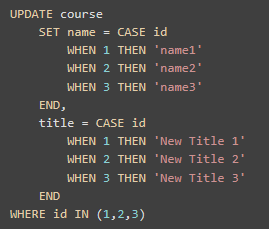<!-- 批量修改 -->
<update id="batachUpdateFieldChild" parameterType="java.util.List">
update yryz_field_child c set
c.designation=
<foreach collection="list" item="fieldChild" index="index"
separator=" " open="case c.id" close="end">
when #{fieldChild.id,jdbcType=INTEGER} then
#{fieldChild.designation,jdbcType=VARCHAR}
</foreach>
,c.attach_code=
<foreach collection="list" item="fieldChild" index="index"
separator=" " open="case c.id" close="end">
when #{fieldChild.id,jdbcType=INTEGER} then
#{fieldChild.attachCode,jdbcType=INTEGER}
</foreach>
where c.id in
<foreach collection="list" index="index" item="fieldChild"
separator="," open="(" close=")">
#{fieldChild.id,jdbcType=INTEGER}
</foreach>
</update>
原理等同于:
update yryz_field_child c set
c.designation= case c.id
when id then attachCode
end
where c.id in (id)
eg:
update yryz_field_child c set
c.designation= case c.id
when 1 then 'hello'
when 2 then 'world'
end
where c.id in (1,2)

eg:
update yryz_field_child c
set c.designation= case c.id
when ? then ?
when ? then ?
when ? then ?
when ? then ?
end
where c.id in ( ? , ? , ? , ? )
public int batachUpdateFieldChild(List<FieldChild> fieldChildList);
@ResponseBody
@POST
@Path("/batachUpdateFieldChild")
public ResultEntity batachUpdateFieldChild(MergeDto mergeDto){
String designationStrs=mergeDto.getDesignation();
String[] designationsBase=designationStrs.split(" ");
String[] newdesignations=arrayResult(designationsBase);
int id=0;String designation="";
List<FieldChild> fieldChildlist=new ArrayList<FieldChild>();
FieldChild fieldChild=null;
for(int i=0;i<newdesignations.length;i++){
String newdesignationsChild=newdesignations[i];
System.out.println(newdesignationsChild);
String[] lastdesignationsChild=newdesignationsChild.split(",");
for(int j=0;j<lastdesignationsChild.length;j++){
id=Integer.valueOf(lastdesignationsChild[0]);
fieldChild=new FieldChild();
designation=lastdesignationsChild[1];
fieldChild.setId(Long.valueOf(id));
fieldChild.setAttachCode(mergeDto.getAttachCode());
fieldChild.setDesignation(designation);
}
fieldChildlist.add(fieldChild);
}
int countChild=fieldChildService.batachUpdateFieldChild(fieldChildlist);
String msg="";
if(countChild>0){
msg="success";
}else{
msg="fail";
}
return new ResultEntity(msg,null);
}
空格进行分割,完了放入array数组中,便利数组存入对象,将对象放入List中
/**
* 对数组进行去重
* @param str
* @return
*/
public static String[] arrayResult(String[] str){
String[] array = str;
Set<String> set = new HashSet<>();
for(int i=0;i<array.length;i++){
set.add(array[i]);
}
String[] arrayResult = (String[]) set.toArray(new String[set.size()]);
return arrayResult;
}